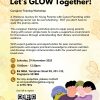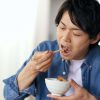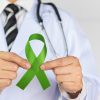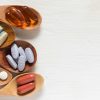Phytoestrogen – Friend or Foe?
The question of whether phytoestrogens can influence breast cancer has long been a subject of intense interest and research, particularly among those affected by the disease. Numerous studies have been conducted to investigate this topic to find the answer.
So, what makes phytoestrogens special? In 2006, researchers Yager and Davidson reported that breast cancer cells are stimulated by estrogens and can multiply through a specific cell metabolism pathway [1]. Another study by Mense and her team found that Asians, particularly in Japan, have lower breast cancer incidence rates compared to Western countries, which is attributed to their higher intake of soy products rich in isoflavones [2]. This has led to increased interest in the potential of soy-based diets to reduce the risk of breast cancer and other hormone-related diseases [3].
However, a study by Micek and team, examining 15 studies on the relationship between phytoestrogen intake and breast cancer incidence, revealed limited evidence for a significant association. Only 2 of the 15 studies qualified for the study of dietary lignan intake and breast cancer survival and showed no significant association [6].
What is Phytoestrogen?
Phytoestrogens are plant-based compounds that has the likeness of mammalian estrogens [4]. They can bind to estrogen receptors, triggering cellular responses, including cell apoptosis [8,9]. The four main classes of phytoestrogens are isoflavones, lignans, stilbenes, and coumestans, with isoflavones and lignans being the most extensively studied [5].
Research has shown a significant association between the long-term consumption of soy products, rich in isoflavones and lignans, and a reduced risk of breast cancer, particularly among women who began consuming soy products at a young age, typically between 13 and 15 years old [8]. This finding has sparked further investigation into the potential protective effects of early soy consumption against cancer. Importantly, studies have indicated that the effectiveness of phytoestrogens may be limited in individuals who adopt a Western diet from a young age, even if they increase their phytoestrogen intake in adulthood [7]. These individuals typically consume an average of 1-3 mg of phytoestrogens per day [2]. In contrast, Asian populations, who traditionally consume higher amounts of soy-based foods from a young age, tend to have higher rates of protection against breast cancer [8]. Their average intake is estimated to be around 50 mg per day [2].
It’s important to note that the effectiveness of phytoestrogens can be influenced by various dietary and lifestyle factors. Epigenetic mechanisms may play a role in the transmission of these effects across generations, with individuals who consume high amounts of phytoestrogens and maintain a phytoestrogen-rich diet potentially passing on these benefits to their offspring [2]. Studies have indicated that Asian immigrants who adopt a Western diet, experience a similar level of phytoestrogen protection as individuals who have always followed a Western diet [2].
A 2020 systematic review concluded that there is currently no specific dosage guideline for phytoestrogen consumption to optimise protection against breast cancer [6]. While the consumption of phytoestrogens from plant-based sources like vegetables and fruits is generally safe, some individuals may experience gastrointestinal discomfort, such as bloating, flatulence, nausea, and changes in bowel movements, due to high fiber intake.
Sources of Phytoestrogen
Isoflavones is a major class of phytoestrogens that is abundant in various plant-based foods, particularly soy products, chickpeas, and green peas. However, boiling can reduce their content by up to 50% [8], so consuming larger quantities may be necessary to reap their benefits. Other dietary sources of phytoestrogens include coffee, nuts, bread, and legumes [10].
Lignans, another significant class of phytoestrogens, are concentrated in flaxseeds [8]. Additional sources include barley, buckwheat, millet, oats, rye, and sesame seeds [11].
Stilbenes can be found in a range of foods, such as cocoa, grapes, peanuts, tomatoes, strawberries, cranberries, and blueberries [12].
Coumestans are present in high quantities in alfalfa, clover sprouts, split peas, pinto beans, and lima beans [13].
The effectiveness of phytoestrogens in reducing breast cancer risk is strongly influenced by early dietary intake. Individuals who increase their phytoestrogen consumption in adulthood after a period of low intake during adolescence may not experience the same level of protection as those who have consistently consumed a high phytoestrogen diet from a young age. The benefits of phytoestrogens may be passed down to subsequent generations if they continue to follow a phytoestrogen-rich diet. It is important to consume phytoestrogen-rich foods in moderation, unless advised otherwise by a healthcare professional. For more healthy recipes, you may check out our healthy 365 recipes.
Reference
-
Yager JD, Davidson NE. Estrogen Carcinogenesis in Breast Cancer. New England Journal of Medicine [Internet]. 2006 Jan 19;354(3):270–82. Https://www.nejm.org/doi/full/10.1056/NEJMra050776
-
Mense SM, Hei TK, Ganju RK, Bhat HK. Phytoestrogens and Breast Cancer Prevention: Possible Mechanisms of Action. Environmental Health Perspectives. 2008 Apr;116(4):426–33. DOI: 10.1289/eph.10538
-
Pelekanou V, Leclercq G. Recent insights into the effect of natural and environmental estrogens on mammary development and carcinogenesis. The International Journal of Developmental Biology. 2011 Jan 1;55(7-8-9):869–78. DOI: 10.1387/ijdb.113369vp.
-
Sirtori CR, Arnoldi A, Johnson SK. Phytoestrogens: end of a tale? Annals of Medicine [Internet]. 2005;37(6):423–38. Available from: https://pubmed.ncbi.nlm.nih.gov/16203615/
-
Moon YJ, Wang X, Morris ME. Dietary flavonoids: Effects on xenobiotic and carcinogen metabolism. Toxicology in Vitro. 2006 Mar;20(2):187–210. DOI: 10.1016/j.tiv.2005.06.048.
-
Micek A, Godos J, Brzostek T, Gniadek A, Favari C, Mena P, et al. Dietary phytoestrogens and biomarkers of their intake in relation to cancer survival and recurrence: a comprehensive systematic review with meta-analysis. Nutrition Reviews. 2020 Jul 6;79(1):42–65. Https://doi.org/10.1093/nutrit/nuaa043
-
Keinan-Boker L, van Der Schouw YT, Grobbee DE, Peeters PH. Dietary phytoestrogens and breast cancer risk. The American Journal of Clinical Nutrition. 2004 Feb 1;79(2):282–8. DOI: 10.1093/ajcn/79.2.282
-
Duffy C, Perez K, Partridge A. Implications of Phytoestrogen Intake for Breast Cancer. CA: A Cancer Journal for Clinicians. 2007 Sep 1;57(5):260–77. DOI: 10.3322/CA.57.5.260
-
Rice S, Whitehead SA. Phytoestrogens and breast cancer –promoters or protectors? Endocrine-Related Cancer. 2006 Dec;995–1015. DOI: 10.1677/erc.1.01159
-
Swann R, Perkins KA, Velentzis LS, Cristian Ciria, Dutton S, Mulligan AA, et al. The DietCompLyf study: A prospective cohort study of breast cancer survival and phytoestrogen consumption. Maturitas. 2013 Jul 1;75(3):232–40. DOI: 10.1016/j.maturitas.2013.03.018.
-
Peterson J, Dwyer J, Adlercreutz H, Scalbert A, Jacques P, McCullough ML. Dietary lignans: physiology and potential for cardiovascular disease risk reduction. Nutrition Reviews. 2010 Sep 28;68(10):571–603. DOI: 10.1111/j.1753-4887.2010.00319.x
-
Reinisalo M, Kårlund A, Koskela A, Kaarniranta K, Karjalainen RO. Polyphenol Stilbenes: Molecular Mechanisms of Defence against Oxidative Stress and Aging-Related Diseases. Oxidative Medicine and Cellular Longevity. 2015;2015:1–24. DOI: 10.1155/2015/340520
-
Rietjens IMCM, Louisse J, Beekmann K. The potential health effects of dietary phytoestrogens. British Journal of Pharmacology [Internet]. 2016 Oct 20;174(11):1263–80. Available from: https://www.ncbi.nlm.nih.gov/pmc/articles/PMC5429336/






